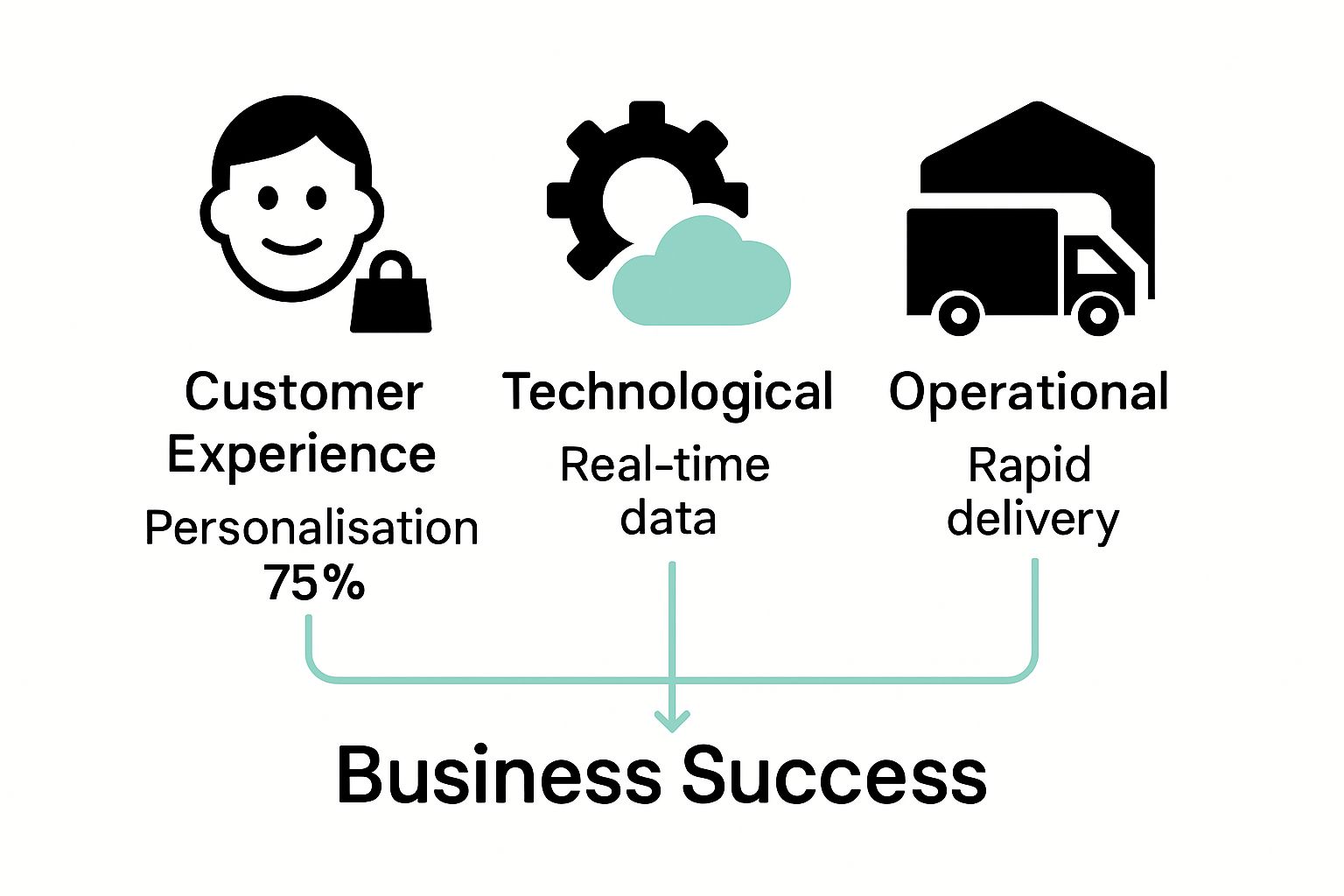E-commerce might seem like a straightforward way to reach millions and grow your business overnight. But despite the digital convenience, online businesses face obstacles far trickier than just processing card payments or running a website. More than 75 percent of consumers now expect companies to predict their needs before even speaking to them. Most brands are caught off guard by just how fast the rules shift and how quickly customer expectations race ahead of technology.
Table of Contents
- What Are E-commerce Challenges And Why Do They Matter?
- The Impact Of Consumer Behaviour On E-commerce Challenges
- Technological Obstacles In The E-commerce Landscape
- Logistical And Operational Hurdles Faced By E-commerce Businesses
- Strategies For Overcoming E-commerce Challenges Effectively
Quick Summary
| Takeaway | Explanation |
|---|---|
| Address e-commerce challenges proactively | A proactive approach can significantly enhance conversion rates and customer retention. |
| Invest in technological infrastructure continuously | Modern e-commerce demands up-to-date tech to meet consumer expectations. |
| Utilise data-driven insights for strategy | Leveraging analytics and predictive models helps in understanding consumer needs. |
| Focus on seamless customer experiences | Prioritising a smooth, personalised shopping journey fosters consumer trust and loyalty. |
| Adopt flexible operational models | Flexibility in operations allows businesses to adapt quickly to market changes and demands. |
What are E-commerce Challenges and Why Do They Matter?
E-commerce challenges represent complex obstacles that online businesses encounter when operating in the digital marketplace. These challenges go beyond simple technical issues and encompass strategic, operational, and customer experience dimensions that can significantly impact a company’s success.
The Fundamental Landscape of Digital Commerce Obstacles
E-commerce challenges emerge from multiple interconnected domains. Understanding digital transformation challenges reveals that businesses must navigate intricate technological, market, and consumer behavioural landscapes.
The following table compares key e-commerce challenges across major business domains, highlighting their specific obstacles and impact on online operations.
| Domain | Representative Challenge | Explanation |
|---|---|---|
| Conversion | Conversion rate optimisation | Difficulty turning visitors into customers |
| Customer Experience | Customer experience management | Meeting rising expectations for personalisation and service |
| Data Privacy & Security | Data privacy and security compliance | Ensuring compliance with regulations and protecting user data |
| Technology Infrastructure | Infrastructure scalability | Adapting platforms and integrations to rapid business growth |
| Marketing Integration | Cross-channel marketing integration | Combining online, offline, and multi-platform marketing strategies |
| The most critical challenges typically involve: |

- Conversion rate optimization
- Customer experience management
- Data privacy and security compliance
- Technological infrastructure scalability
- Cross-channel marketing integration
Economic and Strategic Implications
The significance of e-commerce challenges extends far beyond operational disruptions. According to Deloitte’s Digital Commerce Research, businesses that fail to address these challenges effectively can experience substantial revenue losses and diminished market competitiveness.
Modern e-commerce environments demand sophisticated technological solutions and adaptive strategies that can respond rapidly to changing consumer expectations. The ability to anticipate, understand, and proactively manage these challenges determines whether an online business will thrive or merely survive in an increasingly competitive digital ecosystem.
Consumer Expectations and Technological Evolution
Consumers now expect seamless, personalised shopping experiences that transcend traditional transactional models. This shift requires businesses to invest continuously in technological infrastructure, data analytics, and customer experience design. E-commerce challenges are not static obstacles but dynamic indicators of a business’s capacity to innovate and remain relevant in a rapidly evolving digital marketplace.
The Impact of Consumer Behaviour on E-commerce Challenges
Consumer behaviour represents a dynamic and influential force that continually reshapes the e-commerce landscape, creating unique challenges for online businesses. Understanding these behavioural patterns is crucial for developing strategic responses that address emerging market demands.
Digital Consumer Psychology and Expectations
Exploring technology’s impact on shopping reveals profound shifts in consumer decision-making processes. Modern digital consumers exhibit complex characteristics that significantly challenge traditional e-commerce models:
- Demanding personalised shopping experiences
- Expecting instantaneous information and service
- Requiring seamless cross-platform interactions
- Prioritising transparency and ethical business practices
Data-Driven Consumer Insights
According to Gartner’s Consumer Behaviour Research, approximately 75% of consumers now expect companies to anticipate their needs before direct communication. This expectation creates substantial pressure for businesses to develop advanced predictive analytics and intelligent recommendation systems.
Technological Adaptation and Consumer Trust
E-commerce challenges emerging from consumer behaviour are fundamentally about trust and technological adaptation. Businesses must continuously innovate their digital interfaces, data protection mechanisms, and customer engagement strategies. The most successful online enterprises will be those capable of creating authentic digital experiences that align with evolving consumer expectations while maintaining robust security and privacy standards.
Technological Obstacles in the E-commerce Landscape
Technological obstacles represent critical challenges that impede the seamless functioning of digital commerce platforms. These complex barriers emerge from the intricate interplay between rapidly evolving digital technologies and the increasingly sophisticated expectations of online consumers.
Infrastructure and Integration Complexities
Exploring data analytics challenges for e-commerce in 2025 highlights the fundamental technological hurdles businesses encounter. Modern e-commerce infrastructures must manage intricate technological ecosystems that demand sophisticated integration capabilities:
- Seamless multi-platform compatibility
- Real-time data synchronisation
- Advanced cybersecurity protocols
- Scalable cloud computing resources
- Intelligent machine learning algorithms
Performance and Scalability Challenges
According to McKinsey’s Digital Performance Report, businesses face significant challenges in maintaining optimal technological performance across diverse digital touchpoints. These challenges include managing complex backend systems, ensuring rapid page load speeds, and maintaining consistent user experiences across multiple devices and platforms.
Security and Data Management
E-commerce technological obstacles fundamentally revolve around protecting sensitive customer information while maintaining seamless operational efficiency. Robust data management systems must simultaneously address privacy regulations, prevent potential security breaches, and provide transparent, consent-driven data processing mechanisms. The most successful digital enterprises will be those capable of balancing technological sophistication with user trust and regulatory compliance.
Logistical and Operational Hurdles Faced by E-commerce Businesses
E-commerce businesses encounter intricate logistical and operational challenges that extend far beyond traditional retail paradigms. These complexities represent multifaceted barriers that demand sophisticated strategic approaches and adaptive technological solutions.
Supply Chain and Inventory Management
Understanding data tracking methodologies reveals the critical importance of precise inventory management in digital commerce. Modern e-commerce operations must navigate increasingly complex supply chain ecosystems that require real-time tracking and predictive inventory strategies:
- Maintaining accurate stock levels across multiple platforms
- Managing global supply chain disruptions
- Implementing automated inventory replenishment systems
- Developing flexible warehousing solutions
- Creating agile distribution networks
Fulfilment and Delivery Complexities
According to Deloitte’s Logistics Performance Analysis, e-commerce businesses face unprecedented challenges in creating seamless delivery experiences. Consumers now expect rapid, transparent, and cost-effective shipping that pushes traditional logistical boundaries. This requires businesses to invest in advanced technological infrastructure that can support complex routing, tracking, and customer communication systems.

Operational Scalability and Adaptability
Successful e-commerce enterprises must develop robust operational models capable of rapidly adapting to market fluctuations, technological innovations, and changing consumer expectations. The most effective strategies involve creating flexible technological ecosystems that can scale dynamically, integrate multiple data sources, and provide actionable insights for continuous operational optimization.
Strategies for Overcoming E-commerce Challenges Effectively
Successfully navigating e-commerce challenges requires a comprehensive, strategic approach that integrates technological innovation, data-driven insights, and adaptive business models. Businesses must develop multifaceted strategies that can respond dynamically to the complex digital marketplace.
Data-Driven Strategic Planning
Exploring e-commerce data strategies for 2025 emphasises the critical importance of leveraging advanced analytical approaches. Effective e-commerce strategies demand intelligent data utilisation and predictive decision-making frameworks:
- Implementing comprehensive analytics platforms
- Developing machine learning predictive models
- Creating robust customer segmentation strategies
- Establishing real-time performance monitoring systems
- Integrating cross-platform data insights
Technological Adaptation and Innovation
According to Gartner’s Digital Transformation Research, businesses must continuously invest in technological capabilities that enable rapid adaptation. Strategic technological investments should focus on creating flexible infrastructures that can quickly respond to emerging market demands and technological innovations.
Holistic Organisational Approach
Overcoming e-commerce challenges requires a holistic approach that transcends traditional departmental boundaries. Successful organisations will develop integrated strategies that align technological capabilities, customer experience design, and organisational culture.
This table summarises selected strategic approaches to overcoming e-commerce challenges, aligning each strategy with its core area of focus and intended business benefit.
| Strategy Category | Key Focus Area | Intended Benefit |
|---|---|---|
| Data-driven Planning | Analytics & prediction | Informed decision-making and improved customer insights |
| Technological Innovation | Infrastructure & adaptation | Greater agility and resilience to market shifts |
| Holistic Organisational Approach | Cross-department alignment | Integrated solutions and a responsive company culture |
| This approach necessitates continuous learning, experimentation, and a willingness to challenge existing operational paradigms. |
Empower Your E-commerce Success with Precise Conversion Tracking
Struggling with conversion rate optimisation, inaccurate data, or tracking challenges mentioned in our exploration of e-commerce obstacles? The article highlights how complex technological, data privacy, and consumer behaviour trends can impact your business growth. At AdPage, we understand how critical accurate data collection and analysis are when facing these common e-commerce hurdles. If you are seeking transparent reporting, 100 percent conversion monitoring, and peace of mind regarding GDPR compliance, now is the time to take control of your results.

Are you ready to transform uncertainty into growth? Experience how AdPage’s server-side tagging solutions can help you:
- Accurately track every conversion and overcome data loss from traditional analytics
- Optimise your tracking for platforms like Shopify, WooCommerce, or Magento
- Implement robust consent management for full data compliance
Our platform is designed for e-commerce teams and marketers who want reliable, actionable insights. Do not let technological or operational barriers hold your business back. Visit AdPage today to discover how our tools solve the challenges highlighted in this article. Start your journey towards better data and higher conversions now.
Frequently Asked Questions
What are the main e-commerce challenges businesses face?
E-commerce challenges primarily include conversion rate optimisation, customer experience management, and data privacy compliance. Identify these areas and assess your current performance to pinpoint where improvements can be made.
How can companies enhance customer experience in e-commerce?
To enhance customer experience, businesses should focus on personalisation and seamless cross-platform interactions. Implement feedback mechanisms to understand customer needs and adjust your strategies accordingly, ideally within 30 days.
What steps can be taken to ensure data privacy and security?
Implement robust data management systems that comply with privacy regulations while ensuring operational efficiency. Regularly audit your security protocols and consider enhancing them within the next 60 days to safeguard customer information.
How can businesses improve their supply chain management?
Improving supply chain management involves implementing real-time tracking and automated inventory replenishment systems. Regularly review stock levels and logistics processes to enhance accuracy and response times by approximately 20%.
What are effective strategies for adapting to technological changes in e-commerce?
To adapt to technological changes, continuously invest in adaptable digital infrastructure and leverage predictive analytics. Conduct a technology audit to identify necessary upgrades and focus on these improvements within the next quarter.



.png)
